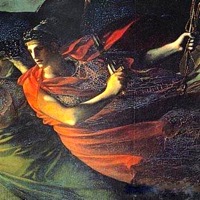Difference between revisions of "Nemesis"
(Created page with 'File:lighterstill.jpgright|frame ==Origin== ''Nemesis'' has been described as the daughter of [http://en.wikipedia.org/wiki/Ocea...') |
m (Text replacement - "http://" to "https://") |
||
| Line 2: | Line 2: | ||
==Origin== | ==Origin== | ||
| − | ''Nemesis'' has been described as the daughter of [ | + | ''Nemesis'' has been described as the daughter of [https://en.wikipedia.org/wiki/Oceanus Oceanus] or [https://en.wikipedia.org/wiki/Zeus Zeus], but according to [https://en.wikipedia.org/wiki/Hesiod Hesiod] she was a child of [https://en.wikipedia.org/wiki/Erebus Erebus] and [https://en.wikipedia.org/wiki/Nyx Nyx]. She has also been described as the daughter of Nyx alone. Her [[cult]] may have originated at [https://en.wikipedia.org/wiki/Smyrna Smyrna]. |
| − | In some metaphysical [[mythology]], ''Nemesis'' produced the egg from which hatched two sets of twins: [ | + | In some metaphysical [[mythology]], ''Nemesis'' produced the egg from which hatched two sets of twins: [https://en.wikipedia.org/wiki/Helen_of_Troy Helen of Troy] and [https://en.wikipedia.org/wiki/Clytemnestra Clytemnestra], and the [https://en.wikipedia.org/wiki/Dioscuri Dioscuri], [https://en.wikipedia.org/wiki/Castor_and_Pollux Castor and Pollux]. While many myths indicate Zeus and Leda to be the [[parents]] of Helen of Troy, the [[author]] of the compilation of myth called ''[https://en.wikipedia.org/wiki/Bibliotheke Bibliotheke]'' notes the possibility of ''Nemesis'' being the mother of Helen; Nemesis, to avoid Zeus, turns into a goose, but he turns into a swan and [[mates]] with her. Nemesis in her bird form lays an egg that is discovered in the marshes by a [[shepherd]], who passes the egg to [https://en.wikipedia.org/wiki/Leda_(mythology) Leda]. It is in this way that Leda comes to be the mother of Helen of Troy, as she kept the egg in a chest until it hatched. |
| − | *[ | + | *[https://en.wikipedia.org/wiki/16th_century 1561] |
The word ''archenemy'' or arch-[[enemy]] originated around the mid-16th century, from the words ''arch''- (from [[Greek]] "arkhos" [[meaning]] "most important") and enemy. | The word ''archenemy'' or arch-[[enemy]] originated around the mid-16th century, from the words ''arch''- (from [[Greek]] "arkhos" [[meaning]] "most important") and enemy. | ||
==Definitions== | ==Definitions== | ||
| Line 16: | Line 16: | ||
*4: An arch[[enemy]], archfoe, archvillain or ''archnemesis'' (sometimes spelled arch-enemy, arch-foe, arch-villain or arch-nemesis, originated around the mid-16th century) is the principal enemy of someone or something. In [[fiction]], it is a character who is the [[hero]]'s worst [[enemy]]. | *4: An arch[[enemy]], archfoe, archvillain or ''archnemesis'' (sometimes spelled arch-enemy, arch-foe, arch-villain or arch-nemesis, originated around the mid-16th century) is the principal enemy of someone or something. In [[fiction]], it is a character who is the [[hero]]'s worst [[enemy]]. | ||
==Description== | ==Description== | ||
| − | In [ | + | In [https://en.wikipedia.org/wiki/Greek_mythology Greek mythology], '''Nemesis''' ([[Greek]], Νέμεσις), also called ''Rhamnousia/Rhamnusia'' ("the goddess of [https://en.wikipedia.org/wiki/Rhamnous Rhamnous]") at her sanctuary at Rhamnous, north of [https://en.wikipedia.org/wiki/Marathon,_Greece Marathon], was the spirit of divine [https://en.wikipedia.org/wiki/Retributive_justice retribution] against those who succumb to [[hubris]] ([[arrogance]] before [[the gods]]). Another name was ''Adrasteia'', meaning "the inescapable." The Greeks [[personified]] vengeful fate as a remorseless goddess: the goddess of [[revenge]]. The name Nemesis is related to the Greek word νέμειν [némein], [[meaning]] "to give what is due".[https://en.wikipedia.org/wiki/Nemesis_(mythology)] |
[[Category: Mythology]] | [[Category: Mythology]] | ||
Latest revision as of 01:35, 13 December 2020
Origin
Nemesis has been described as the daughter of Oceanus or Zeus, but according to Hesiod she was a child of Erebus and Nyx. She has also been described as the daughter of Nyx alone. Her cult may have originated at Smyrna.
In some metaphysical mythology, Nemesis produced the egg from which hatched two sets of twins: Helen of Troy and Clytemnestra, and the Dioscuri, Castor and Pollux. While many myths indicate Zeus and Leda to be the parents of Helen of Troy, the author of the compilation of myth called Bibliotheke notes the possibility of Nemesis being the mother of Helen; Nemesis, to avoid Zeus, turns into a goose, but he turns into a swan and mates with her. Nemesis in her bird form lays an egg that is discovered in the marshes by a shepherd, who passes the egg to Leda. It is in this way that Leda comes to be the mother of Helen of Troy, as she kept the egg in a chest until it hatched.
The word archenemy or arch-enemy originated around the mid-16th century, from the words arch- (from Greek "arkhos" meaning "most important") and enemy.
Definitions
- 1: capitalized : the Greek goddess of retributive justice
- 2: plural nem·e·ses
- a : one that inflicts retribution or vengeance
- b : a formidable and usually victorious rival or opponent
- 3: plural nem·e·ses
a : an act or effect of retribution
- 4: An archenemy, archfoe, archvillain or archnemesis (sometimes spelled arch-enemy, arch-foe, arch-villain or arch-nemesis, originated around the mid-16th century) is the principal enemy of someone or something. In fiction, it is a character who is the hero's worst enemy.
Description
In Greek mythology, Nemesis (Greek, Νέμεσις), also called Rhamnousia/Rhamnusia ("the goddess of Rhamnous") at her sanctuary at Rhamnous, north of Marathon, was the spirit of divine retribution against those who succumb to hubris (arrogance before the gods). Another name was Adrasteia, meaning "the inescapable." The Greeks personified vengeful fate as a remorseless goddess: the goddess of revenge. The name Nemesis is related to the Greek word νέμειν [némein], meaning "to give what is due".[1]
